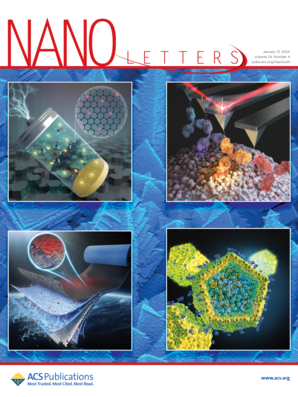Temperature-Responsive Cellulose-Based Janus Hydrogel as Underwater Electronic Skin
IF 9.6
1区 材料科学
Q1 CHEMISTRY, MULTIDISCIPLINARY
引用次数: 0
Abstract
This study develops a Janus-structured hydrogel sensor (P(AA-co-PNIPAM/CDs)) through template-assisted copolymerization of acrylic acid and N-isopropylacrylamide with dopamine-cellulose carbon dots (CDs). The hydrogel demonstrates temperature-responsive strain sensing regulation and enhanced interfacial adhesion, achieving remarkable peel strengths of 237.8 N m–1 (air, 25 °C) and 42.7 N m–1 (water, 50 °C). CD incorporation improves conductivity (1.219 mS cm–1) while reinforcing dynamic adhesion through hydrogen bonding and π–π interactions. The dual-responsive hydrogel exhibits exceptional joint motion monitoring capabilities across diverse environments, maintaining a stable electrical signal output during repetitive stretching (100% strain). Its temperature-modulated underwater adhesion and strain-sensitive conductivity enable the precise detection of both macroscopic movements (joint flexion) and subtle physiological signals (pulse waves). These synergistic properties position P(AA-co-PNIPAM/CDs) as a promising candidate for next-generation smart sensors in athletic monitoring and aquatic robotics, particularly in addressing challenges in underwater wearable electronics and adaptive human–machine interfaces.

温度响应纤维素基Janus水凝胶作为水下电子皮肤
本研究通过模板辅助丙烯酸和n -异丙基丙烯酰胺与多巴胺-纤维素碳点(CDs)的共聚,开发了一种双面结构水凝胶传感器(P(AA-co-PNIPAM/CDs))。水凝胶表现出温度响应应变传感调节和增强的界面附着力,获得了237.8 N m-1(空气,25℃)和42.7 N m-1(水,50℃)的剥离强度。CD的加入提高了电导率(1.219 mS cm-1),同时通过氢键和π -π相互作用增强了动态粘附。双响应水凝胶在不同环境下表现出卓越的关节运动监测能力,在重复拉伸(100%应变)过程中保持稳定的电信号输出。它的温度调制水下附着力和应变敏感电导率使其能够精确检测宏观运动(关节弯曲)和微妙的生理信号(脉冲波)。这些协同特性使P(AA-co-PNIPAM/CDs)成为运动监测和水生机器人中下一代智能传感器的有希望的候选者,特别是在解决水下可穿戴电子设备和自适应人机界面的挑战方面。
本文章由计算机程序翻译,如有差异,请以英文原文为准。
求助全文
约1分钟内获得全文
求助全文
来源期刊

Nano Letters
工程技术-材料科学:综合
CiteScore
16.80
自引率
2.80%
发文量
1182
审稿时长
1.4 months
期刊介绍:
Nano Letters serves as a dynamic platform for promptly disseminating original results in fundamental, applied, and emerging research across all facets of nanoscience and nanotechnology. A pivotal criterion for inclusion within Nano Letters is the convergence of at least two different areas or disciplines, ensuring a rich interdisciplinary scope. The journal is dedicated to fostering exploration in diverse areas, including:
- Experimental and theoretical findings on physical, chemical, and biological phenomena at the nanoscale
- Synthesis, characterization, and processing of organic, inorganic, polymer, and hybrid nanomaterials through physical, chemical, and biological methodologies
- Modeling and simulation of synthetic, assembly, and interaction processes
- Realization of integrated nanostructures and nano-engineered devices exhibiting advanced performance
- Applications of nanoscale materials in living and environmental systems
Nano Letters is committed to advancing and showcasing groundbreaking research that intersects various domains, fostering innovation and collaboration in the ever-evolving field of nanoscience and nanotechnology.
 求助内容:
求助内容: 应助结果提醒方式:
应助结果提醒方式:


